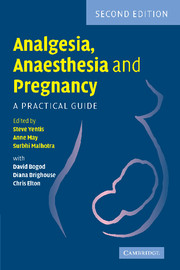Book contents
- Frontmatter
- Contents
- List of contributors
- Preface
- SECTION 1 PRECONCEPTION AND CONCEPTION
- SECTION 2 PREGNANCY
- I Procedures in early/mid-pregnancy
- II Normal pregnancy and delivery
- III Operative delivery and third stage
- IV Anaesthetic complications
- V Problems confined to obstetrics
- VI Problems not confined to obstetrics
- VII The neonate
- SECTION 3 PUERPERIUM AND AFTER
- SECTION 4 ORGANISATIONAL ASPECTS
- Index
I - Procedures in early/mid-pregnancy
Published online by Cambridge University Press: 10 November 2010
- Frontmatter
- Contents
- List of contributors
- Preface
- SECTION 1 PRECONCEPTION AND CONCEPTION
- SECTION 2 PREGNANCY
- I Procedures in early/mid-pregnancy
- II Normal pregnancy and delivery
- III Operative delivery and third stage
- IV Anaesthetic complications
- V Problems confined to obstetrics
- VI Problems not confined to obstetrics
- VII The neonate
- SECTION 3 PUERPERIUM AND AFTER
- SECTION 4 ORGANISATIONAL ASPECTS
- Index
Summary
CERVICAL SUTURE (CERCLAGE)
Cervical suture (Shirodkar or McDonald cerclage) is performed to reduce the incidence of spontaneous miscarriage when there is cervical incompetence. Although it can be done before conception or as an emergency during pregnancy, the procedure is usually performed electively at 12–16 weeks' gestation; it generally takes 10–20 minutes and is performed transvaginally on a day-case basis. A non-absorbable stitch or tape is sutured in a purse-string around the cervical neck at the level of the internal os; this requires anaesthesia since the procedure is at best uncomfortable, although the suture can usually be removed easily without undue discomfort (usually at 37–38 weeks' gestation unless in preterm labour); spontaneous labour usually soon follows.
In patients with a grossly disrupted cervix, e.g. following surgery, placement of the suture via an abdominal approach may be required. Delivery is usually by elective Caesarean section in these cases.
Problems/special considerations
Women undergoing cervical suturing may be especially anxious since previous pregnancies have ended in miscarriage. Otherwise anaesthesia is along standard lines, bearing in mind the risks of anaesthesia in the pregnant woman and monitoring of, and possible effects of drugs on, the fetus (see Chapter 7, Incidental surgery in the pregnant patient, p. 12).
Cerclage may be difficult if the membranes are bulging; the head-down position and/or tocolysis may be requested to counter this.
- Type
- Chapter
- Information
- Analgesia, Anaesthesia and PregnancyA Practical Guide, pp. 7 - 17Publisher: Cambridge University PressPrint publication year: 2007

